
Theory of Markov Chains in Lottery, Lotto, Followers, Pairs, Software
By Ion Saliu, ★ Founder of Lottery Mathematics





Axiomatic one, the Markov Chains theory is very simple and also very hard to comprehend. Why? Because it is many hats to many people. The common ground of this simple example of interaction is randomness. Just about everybody states the Markov Chains only apply to random events. Nice and dandy — but what is not random? The Universe itself is random beyond mathematical doubt. Still a majority of people will say right away that the lottery is random, while the Newtonian system is not. Yet, the Markov Chains do not apply to lottery, because the next drawing is not at all influenced by the previous drawing. Meanwhile, the Newtonian system is closer to being a Markov Chain application because it is far easier to predict the next state!
One much given example of a Markov Chain application is weather forecasting. The weather is "less random" than the lottery. The tomorrow forecast is dependent on today's weather, without the need to go back further in time (the day before yesterday, three days ago, etc.) If the weather state today is, randomly: 40% sunny, 30% cloudy, 30% rainy — tomorrow will be just about the same, but not exactly the same.
I won't go any further and confuse you deeper because the interpretation of the Markov Chains thingy is a huge mess! Fuzzy mathematics is the queen of confusion. As you can discover at this website, my theory of everything is founded on the ubiquitous randomness. Everything, the entire Universe, is random and randomness has rules. The phenomena are differentiated by different probabilities, which in turn determine different degrees of randomness. A lower probability leads to a higher degree of randomness. The Sun appears as a perfect circle from the Earth. The next state (point) in a circle is predictable with a very high degree of certainty (some say absolute certainty). In reality, the Sun is far from being a perfect circle — there are random variations in Sun's shape that are much larger than the Earth! No perfect shape has ever been discovered on Earth or in the Universe.
Furthermore, my theory states that everything is correlated — all events are randomly correlated, if you will. I discovered the third fundamental element of the Fundamental Formula of Gambling: Degree of Certainty. Various degrees of certainty are correlated with various degrees of randomness. Yes, it is more difficult to predict the next lotto draw than to predict tomorrow's weather. If it is hot and sunny and dry today, chances are it won't snow tomorrow. But I can be wrong weather-wise and right lottery-wise! There is no degree of certainty equal to 100% AND no degree of certainty equal to 0 — that's undeniable mathematics, it is axiomaticism.
With the help of computers, I have discovered possibly hundreds of parameters that prove all events are correlated, lottery included. In fact, the first application of my probability theory was lottery and gambling. Hence, I labeled that universal mathematical relation Fundamental Formula of Gambling (FFG). The most descriptive name is Fundamental Formula of Everything (FFE). Everything happens with a degree of certainty determined by a probability and a number of trials.
To make it brief, I noticed that the lotto numbers repeat more often after a number of trials (lottery drawings) equal to or less than the FFG median (one of my fundamental concepts). I discovered also that the lottery numbers have tendencies to pair differently with other numbers. The most frequent lotto pairings will hit more often within certain ranges of drawings. I called the pairing discovery the lotto wonder grid and it is applied by thousands of lottery players worldwide. If applied to lottery, the Markov Chains theory represents a subset of my lotto wonder grid.
The first software implementation of Markov Chains in lottery was first presented at this website in 2003: Markov Chains, Lottery, Lotto, Software, Algorithms, Program. The first Markov Chains Lotto program was the creation of Cristiano Lopes, a system engineer from Portugal/Italy. He was inspired by a college programming book that "predicted" a set of sentences from a previous set of sentences. A word was followed by other words. The algorithm would randomly select from a list of followers. Cristiano Lopes made the algorithm select lotto numbers from a list of numbers that followed the respective number. For example, in the lotto drawings 3 22 24 26 28 49 and 5 22 23 24 36 37, number 22 was followed by the numbers 24 and 23. 24 and 23 represent followers of lotto number 22.
My lotto wonder grid is more encompassing as it pairs the numbers that appeared in the same draw. In this example, it appears that numbers 22 and 24 are well paired. The lotto wonder grid will make a list of all pairs for each lotto number; the pairs are displayed in descending order, from the most frequent to the least frequent. Then, the software will generate combinations only from the top N pairings. The Markov Chains Lotto program generates random combinations from the followers of the respective numbers.
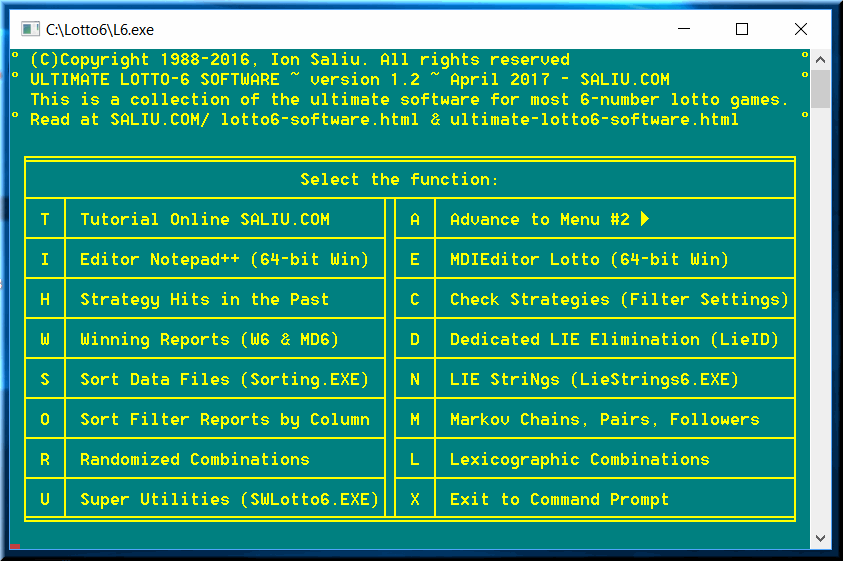
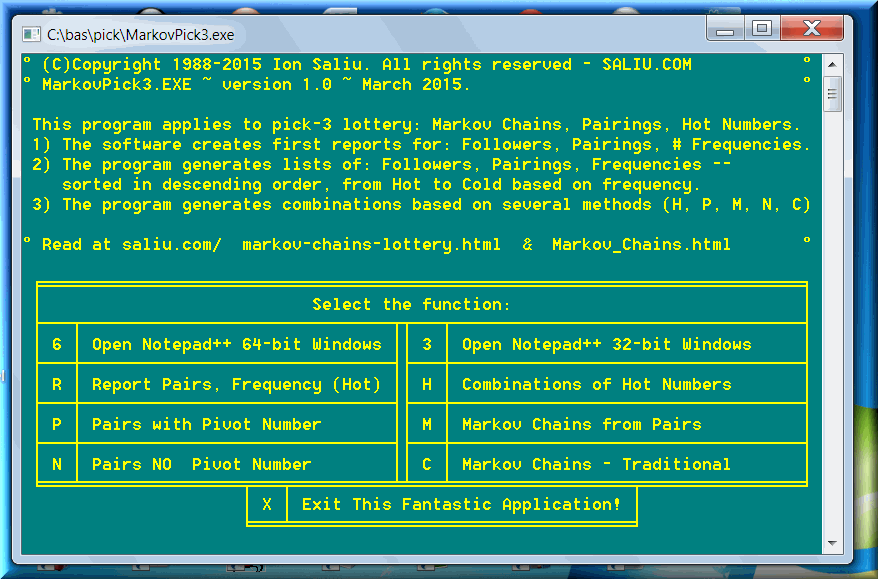
Here is a screenshot of R = Report Pairs, Frequency (Hot).
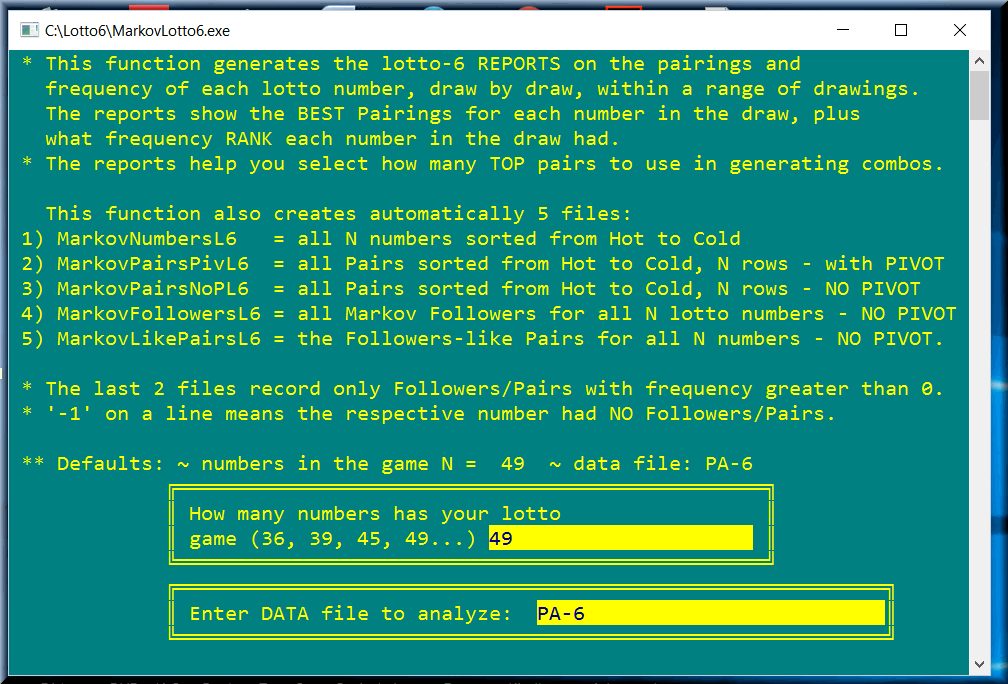
Here is a fragment of the main report, MarkovLotto6.REP:

In addition, Reporting creates automatically 4 files that are needed by the rest of the functions (combinations generators). These text files are as exemplified for the 6-number lotto.
* 22 44 31 37 38 5 46 24 39 42 43 19 23 47 29 14 33 36 2 20 21 4 1 6 25 28 49 18 32 8 34 35 9 10 11 13 41 3 15 26 16 17 30 40 45 7 12 48 27
* 1 43 38 3 27 6 42 8 14 19 22 24 5 30 34 35 2 4 10 44 47 29 41 20 31 26 46 15 49 36 37 13 39 40 11 21 12 32 45 33 16 17 25 18 7 28 23 48 9
* 2 4 39 7 12 18 38 6 14 11 24 28 32 35 37 3 13 27 1 30 31 15 33 9 36 19 10 26 40 45 47 49 22 29 42 8 20 21 5 41 23 44 16 46 25 34 43 17 48
* 3 4 8 1 14 15 38 41 28 30 2 39 12 45 19 34 22 24 26 7 47 23 6 40 32 42 43 33 16 20 31 25 17 11 44 36 29 48 13 18 10 5 27 35 21 46 37 9 49
* 4 10 21 2 14 16 3 29 38 43 39 20 49 36 18 27 41 15 33 32 40 1 7 45 47 8 35 24 37 26 11 28 5 42 30 31 17 48 22 25 34 6 19 9 23 46 13 12 44
...
* 46 44 33 39 9 6 34 17 20 14 38 23 43 5 47 26 29 31 13 7 36 8 1 40 42 11 24 25 35 19 15 27 21 41 22 32 16 45 2 48 28 4 30 37 12 3 10 49 18
* 47 33 39 38 24 25 14 15 20 40 43 6 36 27 44 45 7 13 2 37 3 16 17 42 4 5 1 46 22 41 34 9 18 11 30 19 10 28 21 31 32 8 23 35 12 48 49 29 26
* 48 16 20 38 12 13 5 7 29 33 10 45 23 24 43 21 8 34 26 39 42 28 44 4 32 22 14 35 37 3 19 41 6 9 30 31 46 47 27 18 1 36 15 25 11 49 40 2 17
* 49 4 8 10 11 13 24 28 2 22 35 38 45 21 5 1 25 26 27 9 30 31 32 33 16 18 40 42 20 36 12 39 7 19 14 47 37 15 23 3 41 34 43 44 29 46 6 48 17
* 43 38 3 27 6 42 8 14 19 22 24 5 30 34 35 2 4 10 44 47 29 41 20 31 26 46 15 49 36 37 13 39 40 11 21 12 32 45 33 16 17 25 18 7 28 23 48 9
* 4 39 7 12 18 38 6 14 11 24 28 32 35 37 3 13 27 1 30 31 15 33 9 36 19 10 26 40 45 47 49 22 29 42 8 20 21 5 41 23 44 16 46 25 34 43 17 48
* 4 8 1 14 15 38 41 28 30 2 39 12 45 19 34 22 24 26 7 47 23 6 40 32 42 43 33 16 20 31 25 17 11 44 36 29 48 13 18 10 5 27 35 21 46 37 9 49
* 10 21 2 14 16 3 29 38 43 39 20 49 36 18 27 41 15 33 32 40 1 7 45 47 8 35 24 37 26 11 28 5 42 30 31 17 48 22 25 34 6 19 9 23 46 13 12 44
...
* 44 33 39 9 6 34 17 20 14 38 23 43 5 47 26 29 31 13 7 36 8 1 40 42 11 24 25 35 19 15 27 21 41 22 32 16 45 2 48 28 4 30 37 12 3 10 49 18
* 33 39 38 24 25 14 15 20 40 43 6 36 27 44 45 7 13 2 37 3 16 17 42 4 5 1 46 22 41 34 9 18 11 30 19 10 28 21 31 32 8 23 35 12 48 49 29 26
* 16 20 38 12 13 5 7 29 33 10 45 23 24 43 21 8 34 26 39 42 28 44 4 32 22 14 35 37 3 19 41 6 9 30 31 46 47 27 18 1 36 15 25 11 49 40 2 17
* 4 8 10 11 13 24 28 2 22 35 38 45 21 5 1 25 26 27 9 30 31 32 33 16 18 40 42 20 36 12 39 7 19 14 47 37 15 23 3 41 34 43 44 29 46 6 48 17
2 3 4 5 6 10 17 22
7 4 5 3 16 21 22
11 15 18 22
8 11 10 12 15 18
-1
...
47 4 5 13 23 1
4 6 11 15
-1
1 3 8 9
15 30 11 1 16 2 32 47
1 11 18 42 44
12 13 28 31 34
11 21 26 32 46
-1
...
26 11 20 21 7 32 33 35 40
2 3 15 30 32
-1
4 11 17 33 41
21 23 18 2 4 28 32 42
The program offers defaults for the ranges of analysis or parpalucks. You can also choose your own parameters, of course. You might want to try lower parpaluck values than the defaults. Go back in your data file several draws and check how your strategies would fare.
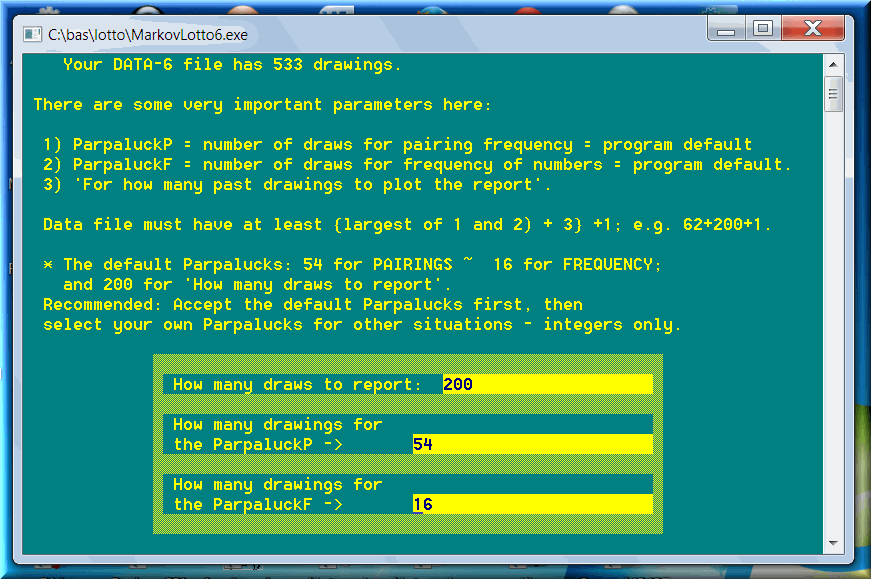
There are 5 combination generating methods in this type of software: Functions H, P, N, M, C in the main menu.
Since the combinations will miss 1 or 2 or even 3 of winning lotto numbers in a real drawing, we can apply the LieID5, or LieID4, or even LieID3 filters. This statement is especially true for the very next lottery drawing, and most likely the next 5-6 draws.
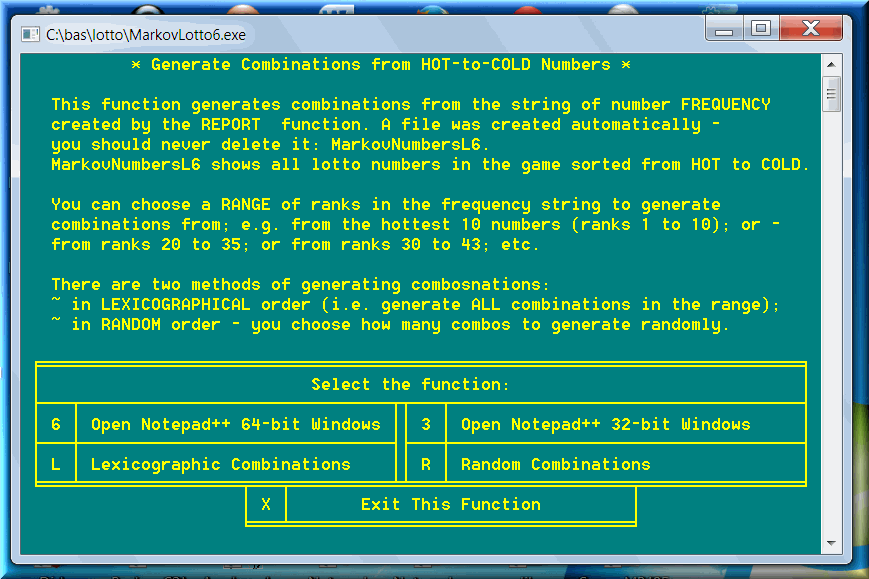

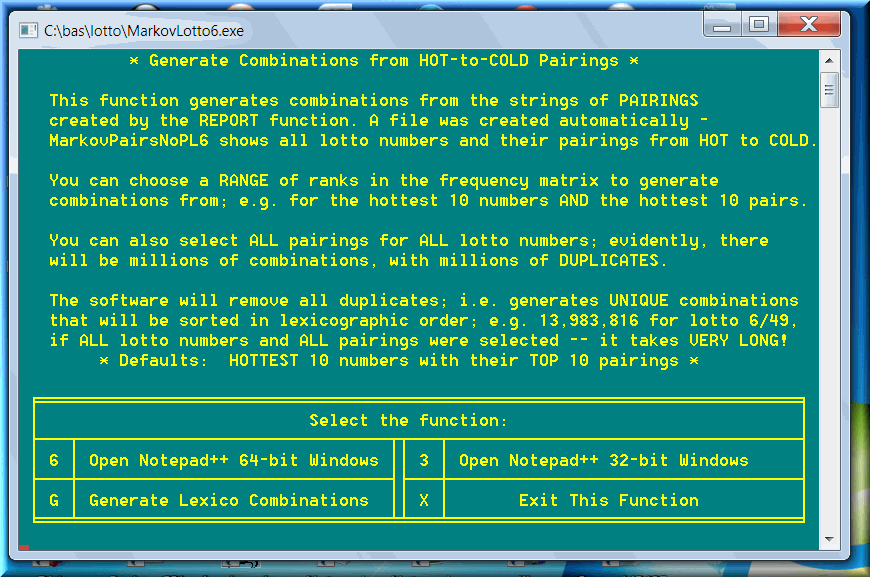
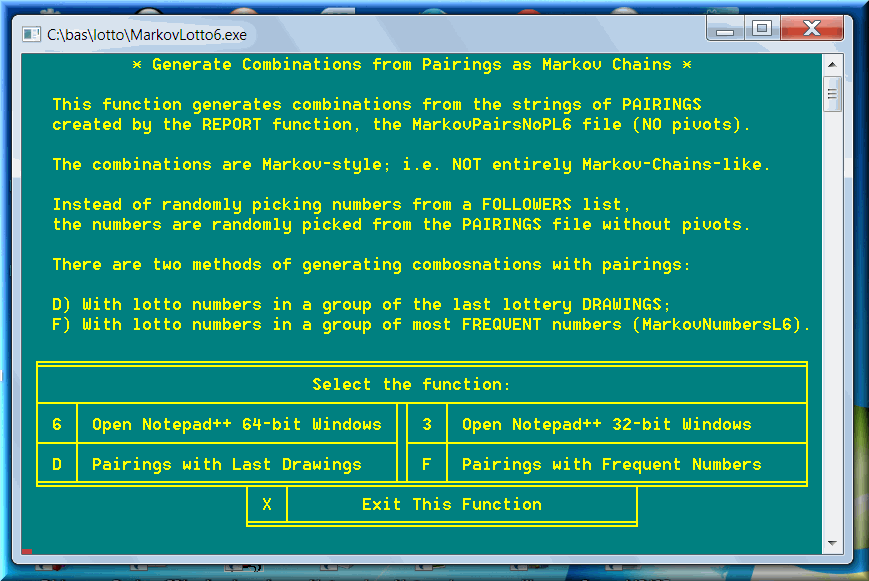
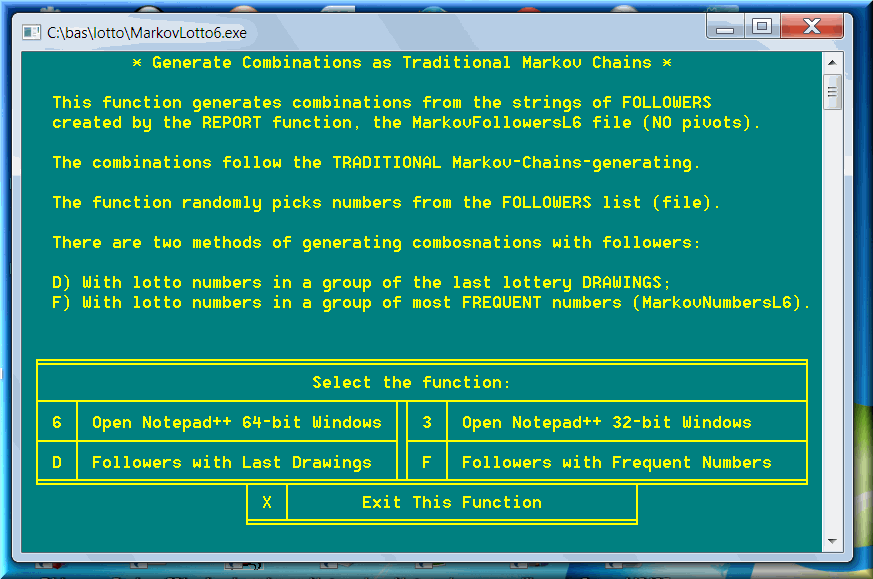
A. You've read in the previous section about one type of lottery strategies created by this type of software: LIE elimination.
B. The other type is straight lottery strategy. That is, generate lottery combinations to win directly, instead of generating and then lie-eliminating.

6. Resources in Lotto Software, Strategies, Lottery Systems
See a comprehensive directory of the pages and materials on the subject of lottery, software, systems, lotto wheels.

Home | Search | New Writings | Fundamental Formula | Odds, Generator | Contents | Forums | Sitemap
